
Introduction
AI agents are no longer a concept for the innovation lab—they’re becoming the operational backbone of the modern enterprise. At Microsoft Build 2025, Satya Nadella described the rise of Researcher Agents as a game-changer, emphasizing how agents who can plan, reason, and act autonomously will “redefine how knowledge work gets done.”
This means AI isn’t just assisting humans anymore —it’s taking on workflows across IT, customer service, marketing, and operations. However, realizing AI’s full potential requires more than fine-tuning a language model or leveraging multiple language models. It demands architected intelligence, where enterprise-grade agents are designed with reliability, safety, and domain specificity.
Enterprise Workflow Is the New Frontier
Enterprise teams today are overwhelmed with repetitive, rule-based tasks that consume time and reduce creativity. AI agents are changing this by executing high-volume, structured workflows that previously required human oversight. In software and IT operations, agents can triage alerts, escalate incidents, and automatically resolve known issues using predefined playbooks. Intelligent merchandising agents dynamically adjust product recommendations based on inventory, demand, and customer behavior in retail. Financial institutions leverage agents to reconcile expense reports, flag anomalies, and initiate approval flows in ERP systems. These are not future ideas—they are being deployed today by enterprises transitioning from rigid automation scripts to adaptive, intelligent workflows.
A Framework for Designing Workflow Agents
To build effective AI agents, it helps to view them as modular, feedback-driven systems. A robust design pattern begins with the Perception Layer, where the agent ingests signals from APIs, logs, or events. The Reasoning Layer then processes these inputs using large language models (LLMs), heuristics, or business rules to determine the appropriate action. The Action Layer handles execution, interacting with enterprise applications and workflows through APIs or robotic process automation (RPA). To make the framework scallable for the future and make it more powerfull, the reasoning and action layers should be able to connect to secure MCP tools (Model context protocol). Finally, a Feedback Loop enables the agent to improve over time by learning from its successes and failures, including human corrections. This structure mirrors what has emerged in frameworks like AutoGen and ReAct. Enterprises should adopt these designs with domain-specific constraints and their existing toolchains.
Risk, Reliability, and Responsible Design
As AI agents begin to act autonomously, ensuring correctness and safety becomes paramount. Preventing hallucinations—where an AI generates false or misleading output—requires grounding techniques, constrained outputs, and validation layers. Observability is essential: every decision, input, action, and outcome should be logged and traceable. Human-in-the-loop (HITL) design patterns are crucial, especially for high-risk tasks, allowing humans to override or approve agent actions. Agents must comply with stringent audit requirements in regulated sectors like healthcare or finance. This means directly incorporating traceability, fallback mechanisms, and compliance checkpoints into their workflows. There will be a application repository of tools that the AI agents could use, but it is critical to ensure that tools are safe to use. Trust must be earned not just through performance but through transparency and control.
Starting Points and Success Metrics
Organizations seeking to implement AI agents should begin with low-risk, repetitive workflows that are easy to integrate with existing systems. Ideal starting points include summarizing documents, drafting email replies, classifying support tickets, code completion or code review, or detecting anomalies. Success should be measured with clear metrics such as time saved, frequency of human overrides, and improvements in accuracy or quality compared to a manual baseline. The goal is enabling teams to do more with less while increasing speed and confidence and also having a feedback loop in model tuning.
Conclusion:
The future of enterprise automation will be built on intelligent agents capable of perceiving, reasoning, acting, and learning. These agents will integrate with one or more MCPs to be more realistic and efficient. As Satya Nadella highlighted, this shift is more than just technological advancement; it fundamentally changes how knowledge work is performed. To thrive in this new era, businesses must go beyond mere experimentation and invest in integrating AI into the core of their operations. Architected intelligence is not optional; it is essential for achieving sustainable, scalable and a safe transformation.






